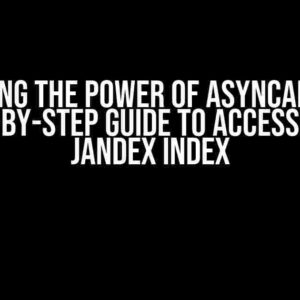Ah, the thrill of venturing into the uncharted territories of socket programming! In this article, we’ll embark on a journey to unravel the mystifying problem of using IPPROTO_RAW with a source address filled in when zero. Yes, you read that right – when zero! So, buckle up, and let’s dive into the world of sockets, protocols, and the intricacies of IPAdresse manipulation.
The Scene of the Crime: Understanding IPPROTO_RAW
IPPROTO_RAW, the raw socket protocol, allows developers to craft custom packets with utmost flexibility. By setting IPPROTO_RAW as the protocol in a socket, you gain control over the entire packet, including the header. Sounds like a dream come true, right? Well, it is, until you stumble upon the peculiar issue we’re about to tackle.
The Problem Statement: Source Address Filled in When Zero
Imagine crafting a packet with IPPROTO_RAW, meticulously setting the source IP address to zero (0.0.0.0), and then… BAM! The kernel decides to fill in the source address with the IP address of the outgoing interface. What sorcery is this?! You asked for zero, but the system gives you a different IP address. Confusion, frustration, and a hint of desperation – welcome to the world of IPADDR manipulation!
Why Does This Happen? Unraveling the Mystery
Before we dive into the solution, let’s understand why this occurs. It’s essential to grasp the fundamental principles of IP address selection and how the kernel handles IPPROTO_RAW packets.
IPPROTO_RAW packets are not subject to the same routing decisions as IPPROTO_TCP or IPPROTO_UDP packets. When using IPPROTO_RAW, the kernel doesn’t perform any route lookups or select an outgoing interface. Instead, it relies on the application to provide a fully-formed packet, including the source IP address.
// sockaddr_in src_addr;
src_addr.sin_addr.s_addr = INADDR_ANY; // 0.0.0.0
In the above code snippet, we’re setting the source address to INADDR_ANY (0.0.0.0). You might expect this to result in a packet with a source IP address of 0.0.0.0, but that’s not what happens. The kernel, being the clever fellow it is, decides to fill in the source address with the IP address of the outgoing interface. This behavior is rooted in the way IP address selection works in Linux.
In Linux, IP address selection is governed by the following rules:
IPADDR_ANY(0.0.0.0) is considered a wildcard address, which allows the kernel to select an appropriate IP address from the available interfaces.- The kernel consults the routing table to determine the outgoing interface and selects an IP address from that interface.
- If no specific IP address is provided, the kernel falls back to the primary IP address of the outgoing interface.
Now, when you set the source address to INADDR_ANY, the kernel follows these rules and selects an IP address from the outgoing interface. This is why you end up with a packet having a source IP address different from the one you specified.
Solving the Enigma: Crafting a Packet with a Zero Source Address
Enough chit-chat! Let’s get to the meat of the matter – crafting a packet with a zero source address using IPPROTO_RAW. There are two approaches to tackle this problem:
Method 1: Using IP_HDRINCL
The first approach involves setting the IP_HDRINCL option in the socket. This option tells the kernel to include the IP header in the packet, allowing you to specify the source IP address manually.
int sockfd = socket(AF_INET, SOCK_RAW, IPPROTO_RAW);
setsockopt(sockfd, IPPROTO_IP, IP_HDRINCL, &one, sizeof(one));
With IP_HDRINCL set, you can now craft the IP header and specify the source IP address as zero.
struct iphdr iph;
// ...
iph.saddr = INADDR_ANY; // 0.0.0.0
sendto(sockfd, &iph, sizeof(iph), 0, (struct sockaddr *)&dest_addr, sizeof(dest_addr));
Method 2: Using a Raw Socket with bind()
The second approach involves binding the socket to a specific IP address before sending the packet. This allows you to specify the source IP address as zero without the kernel interfering.
int sockfd = socket(AF_INET, SOCK_RAW, IPPROTO_RAW);
struct sockaddr_in src_addr;
src_addr.sin_family = AF_INET;
src_addr.sin_port = htons(0);
src_addr.sin_addr.s_addr = INADDR_ANY; // 0.0.0.0
bind(sockfd, (struct sockaddr *)&src_addr, sizeof(src_addr));
sendto(sockfd, &iph, sizeof(iph), 0, (struct sockaddr *)&dest_addr, sizeof(dest_addr));
Conclusion: Unraveling the Mystery of IPPROTO_RAW and Source Address Filling
And there you have it! We’ve demystified the enigmatic behavior of IPPROTO_RAW when dealing with source address filling. By understanding the intricacies of IP address selection and the nuances of raw sockets, we’ve uncovered two solutions to craft packets with a zero source address.
Remember, when working with raw sockets, it’s essential to grasp the underlying mechanics of IP address selection and routing. By doing so, you’ll be well-equipped to tackle even the most mystifying issues in socket programming.
| Method | Description |
|---|---|
| IP_HDRINCL | Sets the IP_HDRINCL option, allowing manual specification of the IP header, including the source IP address. |
| bind() | Binds the socket to a specific IP address, enabling the specification of a zero source IP address. |
In conclusion, the next time you encounter the problem of source address filling when zero, you’ll know exactly how to tackle it. With these solutions, you’ll be well on your way to crafting custom packets like a pro!
Happy socket programming, and may the IP addresses be ever in your favor!
Frequently Asked Question
Get the scoop on the most pressing concerns about using IPPROTO_RAW with source address filled in when zero.
What’s the deal with using IPPROTO_RAW with a source address when it’s set to zero?
When you use IPPROTO_RAW with a source address set to zero, it means the kernel will choose the source address for you. Sounds convenient, right? However, this can lead to issues, especially when sending packets through raw sockets. The kernel might choose an address that’s not routable or not what you intended, causing packet loss or misrouting. So, it’s crucial to specify the source address explicitly to avoid any potential problems.
Why do I get an error when trying to set the source address to zero with IPPROTO_RAW?
The error you’re encountering is likely due to the system’s security features. Modern systems have mechanisms in place to prevent attacks that exploit raw sockets. When you attempt to set the source address to zero, the system assumes you’re trying to spoof the sender’s address, which is not allowed for security reasons. To avoid this error, specify a valid source address that corresponds to one of your system’s network interfaces.
Is there a way to use IPPROTO_RAW with a zero-filled source address without issues?
While it’s not recommended to use a zero-filled source address with IPPROTO_RAW, you can get around the system’s security restrictions by using the CAP_NET_RAW capability. This capability allows your program to bypass certain security checks, including the one that prevents using a zero-filled source address. However, keep in mind that using this capability requires elevated privileges and can compromise system security if not used responsibly.
Can I use IPPROTO_RAW with a source address set to zero in a virtual environment?
The answer depends on the virtual environment you’re using. Some virtualization platforms, like VMware, might allow you to use IPPROTO_RAW with a zero-filled source address without any issues. However, this is not universally true and may vary depending on the specific virtualization software and configuration. It’s essential to check the documentation for your virtual environment to understand any limitations or restrictions that might apply.
What’s the best practice for using IPPROTO_RAW with a source address?
To avoid any potential issues, it’s recommended to always specify a valid source address that corresponds to one of your system’s network interfaces when using IPPROTO_RAW. This ensures that your packets will be routed correctly and reduces the risk of packet loss or misrouting. Additionally, make sure to check your system’s documentation and networking configuration to ensure that the source address you choose is valid and allowed by your system’s security policies.







